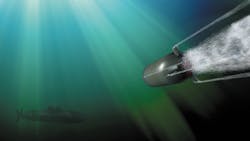Raytheon to provide parts kits to upgrade signal processing and sonar for Navy MK 54 lightweight torpedo
WASHINGTON – Ocean torpedo experts at the Raytheon Co. will provide spare parts kids for the U.S. Navy MK 54 lightweight torpedo under terms of an $80.4 million order announced Friday.
Officials of the Naval Sea Systems Command in Washington are asking the Raytheon Integrated Defense Systems segment in Portsmouth, R.I., to provide MK 54 Lightweight Torpedo MOD 0 and MOD 1 common parts kits and spare torpedo components.
The order is to exercise option year three of the MK 54 lightweight torpedo common parts kit program to supply all-up rounds and upgrade kits.
The Mark 54 torpedo is a lightweight anti-submarine weapon fired from helicopters, fixed-wing aircraft, and from surface vessels. Raytheon is the original Mark 54 designer, and the torpedo combines the sonar homing and warhead subsystems of the Mark 50 torpedo with the propulsion unit of the older Mark 46 light torpedo.
The Mark 54 has better performance than the Mark 46 in shallow-water anti-submarine warfare (ASW), and reduces the costs of the Mark 50 torpedo with commercial off-the-shelf (COTS) components. Navy submarines use advanced versions of the larger Mark 48 heavy torpedo.
The MK 54 Mod 0 integrates hardware and software from the MK 46, MK 50, and MK 48 torpedo programs with state-of-the-art commercial-off-the-shelf (COTS) digital signal processing technology.
It incorporates an advanced guidance and control section with COTS processing technologies and tactical software improvements to increase shallow-water counter-countermeasure capability at reduced costs.
The MK 54 Mod 1 hardware upgrades the torpedo’s sonar array from 52 to 112 elements, providing higher resolution. Software upgrades are designed to exploit these features to improve target detection, enhance false target rejection, and correct previously identified deficiencies.
Related: Lockheed Martin continues upgrading sonar and guidance of Navy submarine-launched torpedo
The MK 54 Mod 0 reached initial operational capability in 2004, while the MK 54 Mod 1 torpedo is scheduled to begin operational testing next year.
The MK 54 can be fired from surface ships via the Mark 32 surface vessel torpedo tubes or the vertical launch anti-submarine rocket (ASROC) systems, and also from most anti-submarine warfare aircraft, although they are slightly different lengths and weights.
Engineers at the Boeing Co. Defense, Space & Security segment in St. Charles, Mo., are building an add-on kit for the Mark 54 that will enable the torpedo to glide through the air from altitudes as high as 30,000 feet and enable the P-8A Poseidon maritime patrol jet to attack enemy submarines from long ranges.
The Boeing High Altitude Anti-Submarine Warfare Weapon Capability (HAAWC) Air Launch Accessory (ALA) turns the Raytheon Mark 54 torpedo into a glide weapon for the P-8A. As the flying torpedo reaches the water, it jettisons wings and other air-control surfaces and takes on its original role as a smart torpedo that detect, track, and attack enemy submarines autonomously.
This order combines purchases for the U.S. Navy, as well as the governments of Canada, the Netherlands, Norway, the United Kingdom, and India. On this order Raytheon will do the work in Portsmouth, R.I., and Keyport, Wash., and should be finished by June 2022.
For more information contact Raytheon Integrated Defense Systems online at www.raytheon.com, or Naval Sea Systems Command at www.navsea.navy.mil.

John Keller | Editor-in-Chief
John Keller is the Editor-in-Chief, Military & Aerospace Electronics Magazine--provides extensive coverage and analysis of enabling electronics and optoelectronic technologies in military, space and commercial aviation applications. John has been a member of the Military & Aerospace Electronics staff since 1989 and chief editor since 1995.

